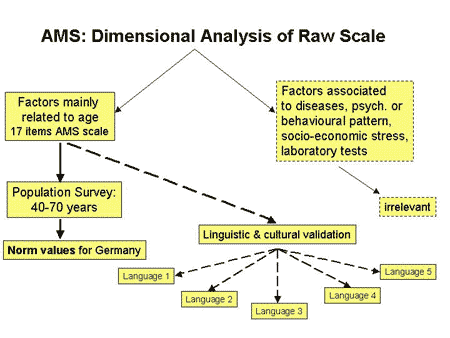Patient-reported outcomes are the basis of the AMS
The Aging Males’ Symptoms (AMS) scale was originally developed in Germany in 1999 5 based on the assumption that – like women during their menopausal transition -men develop similar age-related complaints 6. The scale developed from a listing of symptoms/complaints elucidated via questionnaires completed by otherwise healthy men over the age of 40.
A factorial analysis was applied to establish the raw scale of complaints or symptoms that are not particularly related to diseases, treatment, social and other variables, but related to aging. Statistical methods were used to identify the dimensions of the scale and to reduce the number of items of the raw scale.

Three dimensions of symptoms/complaints were identified in the patients’ group explaining 51.6% of the total variance reducing the number of items within the scale to 17. The three dimensions were:
- a psychological
- a somato-vegetative
- a sexual factor
The final presentation of the scale was applied to a large representative population sample of 992 German males in order to establish reference values for the severity of symptoms in males over 40.
A simple scoring paradigm simplifies the analysis
Details of the scoring can be reviewed on the questionnaires. In summary, a persons score increases incrementally with increasing severity of subjectively perceived complaints in each of the 17 items (severity 1 – 5). The composite scores for each of the dimensions (sub-scales) are obtained by adding up the scores from the respective dimensions. The composite score (total score) is the sum of the dimension scores. The three dimensions, their corresponding questions, and the evaluation are detailed and summarized here.
There have been reports that the normal values of the AMS are age-dependent 21, 22, although, based on our experience, the variation between 45 and 65 years is not impressive. However, this issue and the international comparison of reference values requires further research.
Later developments
Collaborative research initiatives contributed to the development of the AMS scale as a patient-reported outcome (PRO) scale for use in clinical studies in all age groups of men, i.e. healthy and ill persons. This development was summarized in a review from June 2006. This unpublished review is available as a PDF file and was fostered by guidelines developed by the Food and Drug Administration (FDA) on the development of PRO scales.
5. Heinemann LAJ, Zimmermann T, Vermeulen A, Thiel C. A New ‘Aging Male’s Symptoms’ (AMS) Rating Scale. The Aging Male 1999; 2:105-114.
6. Heinemann LAJ, Thiel Ch, Assmann A, Zimmermann T, Hummel W, Vermeulen A. Sex differences of “climacteric symptoms” with increasing age? A pooled analysis of cross-sectional population-based surveys. The Aging Male 2000; 3:124-131.
21. Jankowska EJ, Szklarska A, Lopuszanska M, Medras M (abstract). Male aging and educational level are strong determinants of the intensity of andropausal symptoms in men in Poland. The Aging Male 2004; 7:17.
22. Jankowska EJ, Lopuszanska M, Szklarska A, Medras M (abstract). Hormonal determinants of andropausal symptoms in polish men. The Aging Male 2004; 7:21.
 updated
updated